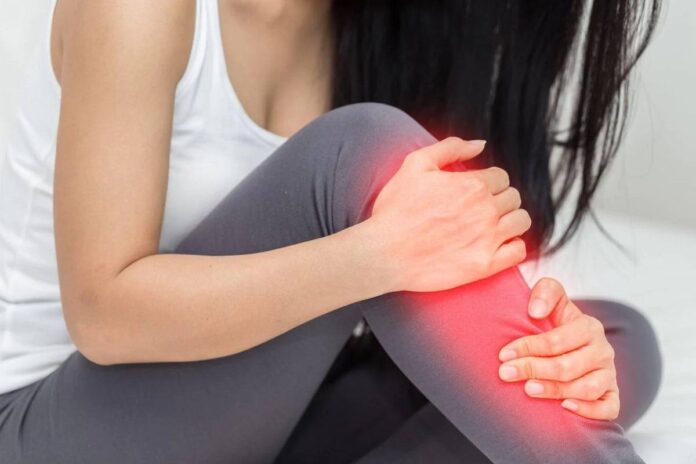The catch-all term “shin splints” refers to a family of overuse injuries causing inflammation of the lower leg—usually the tissues in and around the tibia, or shin bone. Characterized by pain in the lower leg, this condition, also referred to as medial tibial stress syndrome, is the most common overuse injury among runners.
During exercise, the muscles in the lower leg enlarge and press against the compartment formed by the two bones of the lower leg (the tibia and fibula). Repeated stress and pressure can cause irritation of the muscles, tendons, ligaments, or bones. Most commonly, the result is tendinitis. Initially, the pain generally starts during exercise, then after days or even weeks it may disappear during exercise but occur later and then continue during daily activities.
Table of Contents
Symptoms of shin splints
Persistent pain—from mild tenderness to severe aching—in the front or side of the lower leg. The pain generally starts during exercise, but sometimes begins several hours later.
What causes shin splints?
The pain from shin splints is caused by damage to the tissues in and around the tibia that typically results from repeatedly pounding the feet on hard surfaces while running or jumping. Often, shin splints occur when there’s a sudden change in the amount or intensity of activity. People with various biomechanical problems, including overpronation (in which the foot rolls too far inward), are more likely to get shin splints. Seasoned athletes as well as beginners can develop the problem, and it can be compounded by such factors as running on concrete (rather than a softer surface such as grass) or uneven surfaces, as well as by wearing poorly cushioned shoes. Muscle imbalance in the lower leg, differences in leg length, and a weak core can also contribute to shin splints.
What if you do nothing?
At the very least, you will probably need to stop the activity and rest the muscles and connective tissue in the lower leg. Otherwise, the condition is likely to grow progressively worse and become chronic.
Home remedies for shin splints
For mild cases of shin splints, self-treatment measures can usually alleviate the problem. But if you haven’t had this type of pain before, it’s a good idea to consult a physician to get an exact diagnosis, since the cause could also be a stress fracture.
- Rest is essential. Refraining from running and/or jumping for three to six weeks will allow the damaged tissue to heal.
- For pain, use ice and NSAIDs. Applying ice every couple of hours—for no more than 20-minute intervals—can help reduce pain and inflammation. You can use a cold gel pack, ice bag, or a bag of frozen vegetables. Over-the-counter pain relievers (NSAIDs) such as aspirin, ibuprofen, or naproxen can also help relieve pain and swelling.
- Wear shoes that are well-cushioned. The shoes should provide good support and have plenty of impact-absorbing material to cushion the ball and heel areas of your feet.
How to prevent shin splints
These precautions can help you safely return to a full complement of activities—and lessen your risk of reinjury.
- Switch to low-impact activities. Engage in activities such as bicycling, swimming, and pool running until you can resume running or jumping without pain.
- Don’t run in worn-out shoes. If you run regularly, consider replacing shoes every three to six months. Studies have shown that regardless of brand, price, or construction, running shoes lose about 30 percent of their ability to absorb shock after approximately 500 miles of use.
- Don’t run on hard surfaces. Try to avoid cement and concrete, and instead run on grass, school tracks, well-cleared paths, or boardwalks.
- Take it easy. Keep in mind that running more than 20 miles a week doesn’t greatly increase your fitness, but it does increase your chance of injury. Don’t suddenly increase the intensity of your workout. Also avoid excessive downhill running, which places additional stress on the front part of the lower leg. And be sure to warm up before you work out.
- Stretch and strengthen your calf muscles. Do toe raises and foot rolls several times a day; lie on your back and flex your feet; or sit on the edge of a table and flex your foot with a weight attached to it. If you’ve been plagued by shin splints, you should ask your physician to refer you to a physical therapist who will analyze the problem and devise a targeted exercise program.
When to call your doctor
For a first case of shin splints, especially if the pain grows worse or the shin muscles are inflamed and swollen, call your doctor. You should also get medical evaluation if the pain is concentrated in a small area along the inside part of the tibia, rather than extending to the surrounding tissue. This may mean you have a stress fracture—a microscopic break in the shin bone itself. An x-ray or bone scan may be used to diagnose a stress fracture.
Also Read: Strains and Sprains: Causes and Treatments
Also, see your doctor if symptoms persist for more than seven days after self-treatment measures or if pain occurs when you resume running or jumping. You may have tendon or muscle damage that needs additional treatment.
What your doctor will do
In diagnosing the problem, your doctor or a physical therapist will examine your feet and legs to see if an anatomical problem, such as flat feet, might be a factor. Sometimes a podiatrist may recommend an orthotic device (a specially fitted shoe insert), but not everyone benefits from this.




